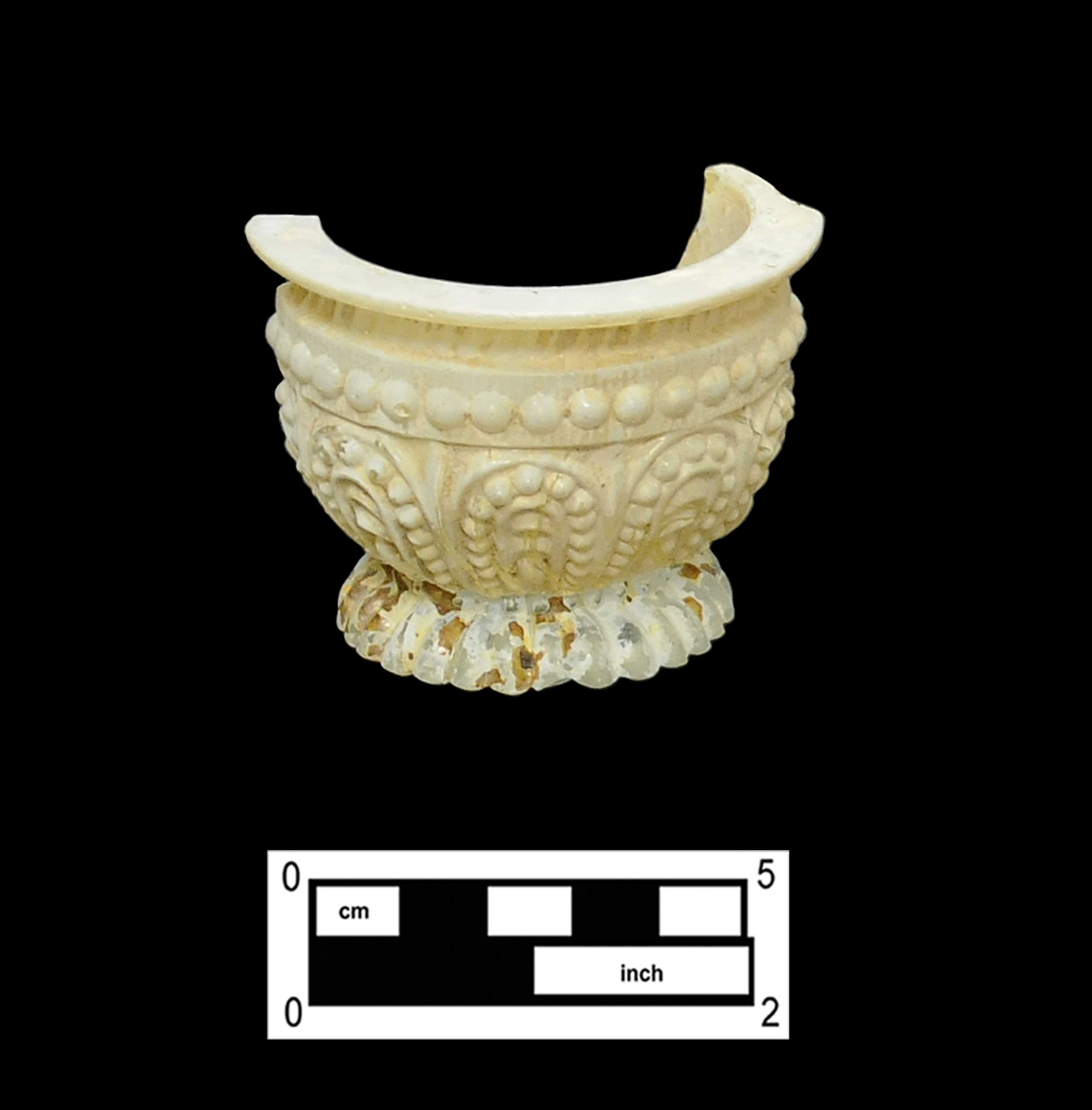Standing Salt or Fancy Pomade
The origins and specific function of this small glass container remain a bit of a mystery. To date, the manufacturer of this style of decorated container—along with the name or model number of the pattern—remains unknown. Several similar containers make up part of the collections of the Corning Museum of Glass, where they are cataloged as salts. Open or master salt dishes were commonly used on the dining table instead of a salt shaker.
This lead glass container is colorless beneath the heavy patina that covers most of the piece. The container stands only 2.13 inches in height, with an internal rim diameter of 2 inches. The details of the decoration are sharp and the design consists of narrow ribs, beads and arches. The Corning example (80.3.51) that most closely matches the recovered artifact is described as: “Colorless glass; pressed. Dimensions: Ht. 5.7 cm, diameter 7 cm. Spherical shape, pattern of arches outlined by beading on sides; row of beading just below plain flat rim; rayed base.” 1 The example from Corning is dated from 1830–1860. 2 This date range seems to connect the recovered artifact with members of the Cramp household.
Jane Spillman, former curator of American glass at Corning, noted that the pressed pattern parallels a blown-molded variation documented by glass collectors/historians George and Helen McKearin in their volume, American Glass, as GV-24. 3 The McKearins also identify this vessel form as a salt dish, and mention variations with an applied handle—referring to them as “baskets.”4 The McKearins also note the similarity of the design to “French Baroque,” although they add that “we have been informed that fragments showing this pattern were unearthed at Sandwich.” 5

Colorless lead glass container with pressed pattern of beaded arches and beaded band beneath flat, flared rim (4A-G-0232).
Two examples of similar dishes in the collection at the Corning Museum of Glass (51.3.317 and 2006.4.241) raise further questions regarding the origins of these containers and their intended use. Both of the containers are made of opalescent glass and each is marked on the foot “R. & G. A. Wright, Philadelphia.” 6 Richard and George A. Wright were listed as perfumers and importers of fancy goods in Philadelphia between 1844 and 1876. 7
On December 25, 1844, the Wrights advertised: “Paris and London Fancy Articles- Just received, by the last arrivals an assortment of elegant Fancy Articles, suitable for Holiday presents. The styles are entirely new and beautiful, and the attention of purchasers is solicited. R. & G.A. Wright, Importers No. 23 South Fourth St.” 8 Another advertisement, from December 6, 1852, described “a large assortment of new styles of English, French and German Fancy articles” offered among the ceramic figurines, and papier mache goods were “Bohemian glass vases and toilet bottles…” 9 The Wrights also manufactured and sold perfumes, hair dye, and pomades, some of which were likely packaged in fancy glass containers, possibly made in American glass factories in styles similar to the imported goods.
References
- Corning Museum of Glass, Collection, accessed September 8, 2017, https://www.cmog.org/artwork/salt-186?search=collection%3Ad604285dea64404d76738c7fc934f3f5&page=0. ↩
- Corning Museum of Glass, Collection, accessed September 8, 2017, https://www.cmog.org/artwork/salt-186?search=collection%3Ad604285dea64404d76738c7fc934f3f5&page=0; Jane Shandel-Spillman, American and European Pressed Glass in the Corning Museum of Glass (Corning, NY: The Corning Museum of Glass, 1981), 394. ↩
- George S. and Helen McKearin, American Glass (New York, NY: Crown Publishers Inc., 1950), Plate 99. ↩
- Ibid., 272. ↩
- Ibid. ↩
- Corning Museum of Glass, Collection, accessed September 8, 2017, http://www.cmog.org/artwork/footed-bowl-or-salt?search=collection%3Ab05fa3f04ed3a784c0518bff6c648cb3&page=0; ibid., http://www.cmog.org/artwork/salt-207. ↩
- McElroy’s Philadelphia City Directory for 1844, “Philadelphia City Directories,” subscription database accessed October 2013, https://www.fold3.com, entry for Richard Wright, p. 349.; McElroy’s Philadelphia Directory for 1861, entry for R. & G.A. Wright, p. 1091; James Gopsill, Philadelphia City Directory for 1876, entry for Richard Wright, p. 1640. ↩
- “Paris and London Fancy Articles,” advertisement, Public Ledger (Philadelphia), December 25, 1844, p. 2, Genealogy Bank, subscription database accessed September 2017, http://www.genealogybank.com. ↩
- “Fancy Goods for the Holidays,” advertisement, Public Ledger, December 6, 1852, p. 2, Genealogy Bank, subscription database accessed September 2017, http://www.genealogybank.com. ↩







